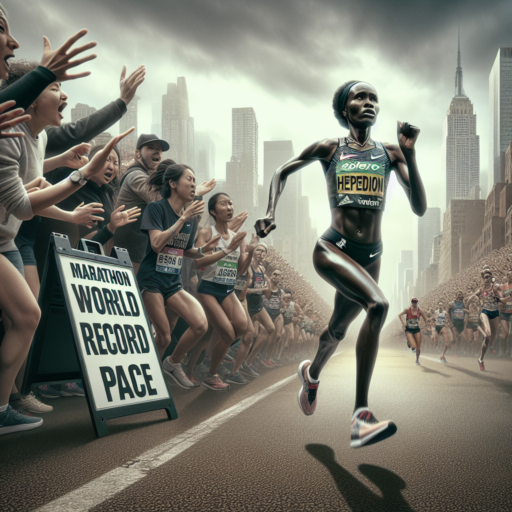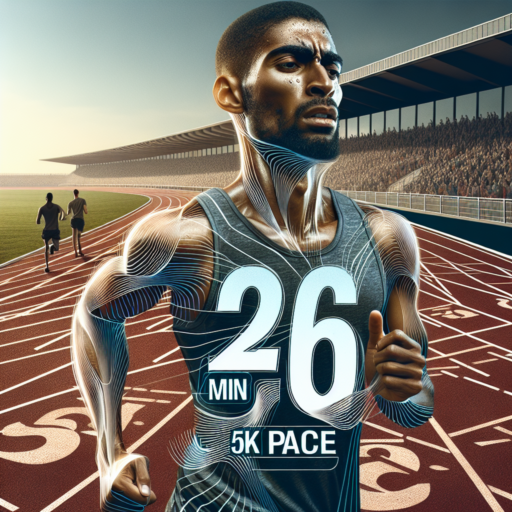Introduction to Marathon World Record Pace
The fascination with the marathon world record pace is not just about the numbers on the clock; it embodies the pinnacle of human endurance, strategy, and the relentless pursuit of breaking barriers. What makes this pace so awe-inspiring is not only the speed at which athletes complete 42.195 kilometers but the evolution of strategies, training methodologies, and even footwear that have contributed to its continual downfall.
At the heart of the marathon world record pace is a blend of raw athleticism and advanced science. The current world records are a testament to how far athletes have pushed the boundaries of what was once deemed physically impossible. Each step at this pace is calculated, with energy conservation and efficiency being as crucial as the speed itself. Understanding the intricacies of this pace helps in appreciating the monumental efforts required to achieve such a feat.
The conversation around marathon world record pace often revolves around elite athletes who dedicate years of their lives to shaving off seconds from their times. It’s a combination of genetic predisposition, rigorous training schedules, dietary regimes, and mental toughness. The advancements in technology, particularly in terms of running gear, also play a significant role in aiding athletes to perform at their best.
Evolution of the Marathon World Record Over Time
The history of the marathon world record is a testament to human endurance and determination. Over the decades, the record has been pushed to new limits, reflecting not only advancements in training and nutrition but also the indomitable spirit of marathon runners. From humble beginnings to the breathtaking performances of today, the evolution of the marathon world record is a journey through time, showcasing the relentless pursuit of excellence.
The Pioneering Days
The marathon world record has come a long way since its unofficial inception in the early 20th century. Initially, marathon times were modest by today’s standards, with runners navigating courses that were often crude by modern criteria. The early record holders laid the groundwork for future generations, inching the mark forward through sheer grit and determination.
The Mid-20th Century Leap
The mid-20th century marked a pivotal era in the evolution of the marathon world record. This period witnessed technological advances in footwear and a deeper understanding of sports science, leading to significant improvements in marathon performances. Runners began to break the 2:20 barrier, setting the stage for the explosive progress to come.
The Modern Era Breakthroughs
In recent decades, the marathon world record has seen unprecedented improvements, with elite athletes shattering previous records. The advent of elite training programs, coupled with advances in nutrition and recovery techniques, has propelled marathon runners to achieve times once thought impossible. The current world record holders are a testament to the modern era’s breakthroughs, pushing the boundaries of what is possible in marathon running.
Understanding Marathon World Record Pace: Key Factors
The quest to comprehend the marathon world record pace unfolds into an intricate analysis of various essential elements. At its core, establishing a new benchmark in marathon running is not solely about raw speed or enduring strength; it’s a multifaceted equation that involves critical physiological, psychological, and environmental factors.
Physiological endurance is paramount in achieving a marathon world record pace. Elite athletes undergo years of intense training to enhance their VO2 max, lactate threshold, and running economy. These components collectively determine an athlete’s capacity to sustain high-intensity efforts over the marathon’s 42.195 kilometers. Further intensifying the challenge is the psychological resilience required to maintain focus and push through the inevitable walls of physical and mental fatigue.
Key Environmental Factors
The role of environmental conditions in setting a marathon world record cannot be overstated. Optimal temperatures, minimal wind resistance, and a carefully designed course layout are pivotal in facilitating record-breaking performances. Races renowned for their fast courses, such as the Berlin Marathon, frequently witness attempts at world record paces due in part to these meticulously controlled conditions. Athletes and organizers alike meticulously plan for these elements, understanding that even the most subtle variations in weather or course elevation can impact the outcome of the race significantly.
Training Techniques to Achieve Marathon World Record Pace
Striving for a marathon world record pace involves a meticulous blend of endurance, speed, and strategy. A fundamental approach is integrating varied running workouts into your regimen. This technique ensures that your body adapts to different paces, enhancing both your speed and stamina. Specifically, a combination of long slow distance runs, tempo runs, and interval training forms a comprehensive training module aimed at achieving peak performance.
Long Slow Distance Runs
Long Slow Distance (LSD) runs are crucial for building endurance, an essential element for marathon success. These runs are performed at a controlled pace, significantly slower than your target marathon pace, promoting mitochondrial development and enhancing aerobic capacity. LSD runs train your body to utilize fat as a primary energy source, preserving glycogen stores for the latter stages of the marathon.
Tempo Runs
Integrating tempo runs into your training schedule hones your ability to sustain a high pace over a significant distance. These runs are typically conducted at a pace you can maintain for an hour, pushing the threshold of your aerobic capabilities without overextending. Such training is vital for improving lactate threshold, enabling you to run faster for longer periods without succumbing to fatigue.
Interval Training
To achieve marathon world record pace, incorporating interval training is indispensable. This form of training involves short bursts of high-intensity running followed by periods of rest or low-intensity running. Interval training boosts your VO2 max, elevating your body’s capacity to use oxygen efficiently. Furthermore, it trains your body to recover quickly, a critical factor in maintaining pace throughout a marathon.
Comparing Men’s and Women’s Marathon World Records
The rivalry between men’s and women’s marathon world records has always been a topic of intrigue and admiration in the athletic community. Analyzing the progression of these records offers insight into the evolution of human endurance and the different physiological adaptations between genders. While male athletes currently hold faster times, the gap between men’s and women’s marathon records has been narrowing, indicating a significant improvement in women’s long-distance running capabilities.
Historical Overview
The marathon world records have seen dramatic improvements over the years, reflecting advancements in training, nutrition, and running technology. For men, the record has been pushed to just over two hours, a benchmark that seemed unreachable decades ago. In contrast, women have also shattered expectations, slicing minutes off the record to edge closer to their male counterparts. This parallel evolution underscores not only the competitive nature of the sport but also the relentless pursuit of excellence among marathon runners.
Physiological Considerations
A critical aspect of this comparison involves understanding the physiological differences that influence marathon performance. Men typically have a higher percentage of fast-twitch muscle fibers and greater cardiovascular capacity, which can contribute to faster race times. Women, on the other hand, often possess superior endurance and a higher percentage of body fat, which can be advantageous for long-distance events. These differences highlight the unique challenges and strengths each gender brings to marathon running.
In conclusion, the comparison between men’s and women’s marathon world records not only celebrates human athletic achievement but also showcases the nuanced interplay of biology, training, and determination. As record holders continue to push the boundaries of what is possible, the marathon remains a testament to the enduring spirit of competition and excellence in sports.
Diet and Nutrition for Marathon Runners at World Record Pace
When aiming for that elusive world record pace, marathon runners need to fuel their bodies with a precision-tuned diet and nutrition strategy. It’s not just about eating healthy; it’s about consuming the right balance of nutrients at the optimal times to boost endurance, speed recovery, and improve overall performance. This piece delves into the heart of what makes up an effective nutritional game plan for those targeting the pinnacle of marathon achievements.
Key Nutritional Components
- Carbohydrates: As the primary energy source for distance runners, a diet rich in high-quality carbohydrates is essential. Options like whole grains, fruits, and vegetables not only provide the fuel required to sustain long-distance efforts but also ensure a steady release of energy.
- Proteins: Adequate protein intake supports muscle repair and growth. Including a variety of proteins such as lean meats, fish, legumes, and plant-based proteins helps in recovery after intense training sessions.
- Fats: Healthy fats are crucial for overall health and can be an important energy source on longer runs. Focus on unsaturated fats found in foods like avocado, nuts, and olive oil.
Timing Your Nutrition
Eating the right nutrients is only part of the equation; knowing when to eat them plays a crucial role in optimizing performance and recovery. Targeting carbohydrate intake during long runs helps sustain energy levels, while protein intake post-workout aids in muscle recovery. Incorporating small, nutrient-dense snacks throughout the day can also maintain a continuous supply of energy and support metabolic health, while timing carb-loading correctly before a race ensures maximum energy availability.
Ultimately, the route to achieving a world record marathon pace requires a meticulous approach to diet and nutrition, tailoring your food intake to the demands of training and recovery. Understanding and implementing these nutrition principles can be the difference-maker for marathon runners pushing the boundaries of human endurance and speed.
No se han encontrado productos.
The Role of Technology in Breaking Marathon Records
In the competitive realm of marathon running, technology has carved a pivotal role in pushing the boundaries of what athletes can achieve. The recent years have witnessed a paradigm shift in how records are broken, attributing much of this success to the sophisticated advancements in technology. From state-of-the-art training methodologies to breakthroughs in gear and equipment, technology’s role is undeniably transformative.
Advancements in Running Gear
One of the most notable technological advancements affecting marathon records is the evolution of running shoes. Modern running shoes are engineered for optimal performance, leveraging materials that offer unprecedented energy return and cushioning. This not only enhances the athlete’s speed but also significantly reduces the risk of injury, allowing for more intense and frequent training sessions. Coupled with apparel designed to reduce drag and control body temperature, runners are equipped like never before to challenge existing marathon records.
High-tech Training Methods
Beyond gear, technology has revolutionized training methodologies. High-altitude training environments can now be simulated with hyperbaric chambers, enabling athletes to train under optimal conditions regardless of their geographic location. Data analytics and biometric monitoring have also become indispensable tools. These allow for personalized training programs by analyzing everything from an athlete’s heart rate and oxygen usage to their running technique. This level of meticulous customization in training protocols directly contributes to improved performance and the shattering of marathon records.
Legendary Runners and Their Marathon World Record Stories
The realm of marathon running is adorned with astonishing tales of human endurance and record-shattering performances. Among them, certain legendary runners stand out not just for their unbreakable records but also for the inspirational stories behind their marathon successes. These champions have not only pushed the boundaries of what’s physically possible but have also left an indelible mark in the history of athletics, captivating fans and aspiring athletes worldwide.
Eliud Kipchoge: Redefining Marathon Limits
One cannot discuss marathon records without mentioning Eliud Kipchoge, a name synonymous with resilience and unmatched performance. Kipchoge, hailing from Kenya, shattered the marathon world record in Berlin in 2018, clocking an astonishing 2 hours, 1 minute, and 39 seconds. His journey from the humble beginnings to becoming a marathon legend epitomizes the spirit of determination and the relentless pursuit of excellence. Kipchoge’s record is not just a testament to his physical capability but to his mental fortitude, serving as a beacon of inspiration for runners everywhere.
Paula Radcliffe: A Beacon for Women’s Marathon
In the realm of women’s marathon, Paula Radcliffe stands tall as a monumental figure. The British runner etched her name into history books in 2003, when she completed the London Marathon in 2 hours, 15 minutes, and 25 seconds, setting a world record that would stand unchallenged for years. Radcliffe’s story is one of overcoming adversity, dealing with injuries and setbacks, yet never losing sight of her goals. Her achievements have significantly influenced the perception of women’s long-distance running, inspiring a generation of female athletes to chase their marathon dreams.
Future Predictions: How Fast Can the Marathon World Record Pace Go?
The marathon world record has seen significant improvements over the decades, spurred by advancements in training, nutrition, and running technology. This raises an intriguing question about the limits of human performance: How fast can we theoretically expect the marathon world record pace to go in the future? Experts in sports science and physiology suggest that while physical and environmental factors set boundaries, breakthroughs in understanding human limits and performance enhancement strategies could see these boundaries pushed even further.
Historically, each new record has often been accompanied by innovations in training methodologies, recovery processes, and even race tactics. Moreover, the development of specialized running gear and footwear designed to maximize efficiency and reduce injury risk has contributed to faster race times. As these trends continue, it’s plausible to anticipate further declines in marathon times, albeit at potentially diminishing rates of improvement.
Another critical factor in the equation is the role of genetic talent and elite athlete development programs. With global interest in marathoning at an all-time high, the pool of potential record-breaking athletes has grown substantially. This increase in competition, combined with more scientific approaches to athlete selection and training, means the marathon world record could continue to be broken, pushing human capabilities to new heights.
Conclusion: The Significance of the Marathon World Record in Athletics
The marathon world record is more than just a time; it’s a symbol of human endurance, dedication, and the relentless pursuit of excellence. This record is not merely a notch on an athlete’s belt but a milestone that elevates the standards and expectations in the world of athletics. It showcases the epitome of physical and mental fortitude required to conquer one of the most grueling distances in the sport. The significance of setting a new marathon world record reverberates throughout the athletic community, inspiring both seasoned runners and newcomers to push beyond their perceivable limits.
Moreover, each new record set in the marathon world is a testimony to the advancement in training methodologies, nutrition, and sports technology. It reflects how athletes, alongside their coaches and support teams, are constantly innovating and finding new edges to break through previous barriers. The marathon world record acts as a benchmark that motivates the entire field of distance running to evolve, adapt, and strive for even greater achievements. This ongoing quest for excellence not only propels athletes to greatness but also captivates the imagination of spectators and sports enthusiasts around the globe.
Furthermore, the ripple effect of a new marathon world record is seen in the increased participation and interest in marathon running as a sport. Following such breakthrough performances, there is often a surge in registrations for marathons worldwide, highlighting the influential role these records play in promoting physical fitness and a healthy, active lifestyle among people of all ages. The marathon world record stands as a powerful catalyst for positive change, encouraging individuals to set and pursue their own personal goals, regardless of how insurmountable they may seem.




